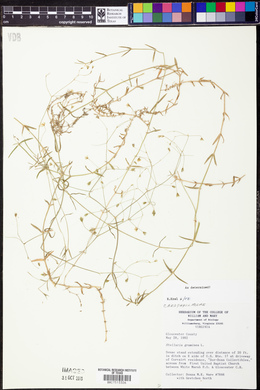Stellaria graminea
|
|
|
|
Family: Caryophyllaceae
Grass-Leaf Starwort, more...common starwort, common stitchwort, grass-leaved starwort, grass-leaved stitchwort
|
Plants perennial, coarse, rhi-zomatous; rhizomes slender, elongate. Stems decumbent or ascending, straggling, diffusely branched, smoothly 4-angled, 20-90 cm, brittle, glabrous. Leaves sessile; blade linear-lanceolate to narrowly lanceolate, widest near base, 1.5-4 cm × 1-6 mm, base round, margins smooth, apex acute, often ciliate near base, otherwise glabrous, not glaucous. Inflorescences terminal, 5-many-flowered, open, conspicuously branched cymes; bracts narrowly lanceolate, 1-5 mm, wholly scarious, margins ciliate, apex acuminate. Pedicels divaricate, 10-30 mm, glabrous. Flowers 5-12 mm diam., rarely larger; sepals 5, distinctly 3-veined, narrowly lanceolate to triangular, 3-7 mm, margins narrow, straight, scarious, apex acute, glabrous; petals 5, 3-7 mm, equaling or longer than sepals; stamens 10, all, some, or none fully developed and fertile; styles 3, ascending, ca. 3 mm. Capsules green or straw colored, narrowly ovoid, 5-7 mm, longer than sepals, apex acute, opening by 3 valves, splitting into 6; carpophore absent. Seeds reddish brown, reniform-rotund, ca. 1 mm diam., rugose in concentric rings. 2n = 39, 52. Flowering late spring-early summer. Rough grasslands, pastures, hayfields, roadsides; 0-1200 m; introduced; St. Pierre and Miquelon; B.C., N.B., Nfld. and Labr., N.S., Ont., P.E.I., Que.; Calif., Colo., Conn., D.C., Idaho, Ill., Ind., Iowa, Kans., Ky., Maine, Mass., Mich., Minn., Mo., Mont., Nev., N.H., N.J., N.Y., N.C., Ohio, Oreg., Pa., R.I., S.C., Tenn., Vt., Va., Wash., W.Va., Wis.; Europe. In Europe, both diploid and tetraploid cytotypes of Stellaria graminea occur with occasional triploid hybrids. Only the tetraploid form has been found in North America, except for a triploid colony in Newfoundland. This species is often confused with S. longifolia but differs in its stems, which are very angular, glabrous, and not scabrid; the narrowly triangular leaves on the flowering stems; the smooth leaf margins; the stiff, triangular, prominently 3-veined sepals; and the larger, rugulose seeds. The sterile overwintering shoots of Stellaria graminea have broader elliptic to elliptic-lanceolate leaf blades measuring 5-15 × 1.5-4 mm. They are broadest near the middle. This state of the plant has been named var. latifolia Petermann. Usually S. graminea has perfect flowers but occasionally plants that are entirely staminate-sterile are encountered. The flowers in these are partially fertile depending on the occurrence of cross- pollination.
Perennial herb with slender rhizomes 20 cm - 1 m tall Stem: ascending or decumbent, straggling, widely branched, four-angled, weak, brittle. Leaves: opposite, stalkless, 1.5 - 5 cm long, 1.5 - 7 mm wide, linear to narrowly lance-shaped with a rounded base and pointed tip, widest near the base, one-veined, often with a marginal fringe of hairs at the base. Inflorescence: a terminal, widely branched, open cluster (cyme) of five to many flowers, subtended by a pair of bracts. Bracts 1 - 5 mm long, narrowly lance-shaped, scarious-margined (dry, thin, and membranous), and with a marginal fringe of hairs (at least at the base). Flowers: white, 5 - 12 mm wide. Stalk spreading or reflexed, slender, 1 - 3 cm long. Stamens ten. Styles three. Sepals: five, distinct, green, 3 - 7 mm long, triangular to narrowly lance-shaped with a pointed tip, strongly three-veined, scarious-margined (dry, thin, and membranous), with a marginal fringe of hairs (at least at the base). Petals: five, white, 3 - 7 mm long, equal to or longer than sepals, deeply two-lobed (giving the appearance of ten petals). Fruit: a dehiscent capsule, opening by three valves, splitting into six, green or straw-colored, 5 - 7 mm long, usually longer than sepals, narrowly egg-shaped with a pointed apex. Seeds reddish brown, about 1 mm wide, rounded to kidney-shaped, laterally compressed, wrinkled in concentric rings. Similar species: The similar Stellaria crassifolia differs by having completely hairless leaves, solitary flowers that grow in the forks of stems, and bracts without scarious margins. Stellaria longifolia is also similar but has weakly veined sepals and smooth seeds. Flowering: mid-May to early August Habitat and ecology: Introduced from Europe. An occasional weed in grassy areas, especially where it is infrequently mowed. Occurence in the Chicago region: non-native Etymology: Stellaria comes from the Latin words stella, meaning star, and -aria meaning "pertaining to," referring to the shape of the flowers. Graminea means grass-like. Author: The Morton Arboretum Perennial; stems weak, 3-5 dm, glabrous or sometimes scabrous on the 4 prominent angles; lvs 1.5-5 cm נ1.5-7 mm, linear to lance-linear, often ciliate at base; infl terminal, diffuse, often extending half-way to the base; bracts scarious, ciliolate at the base; pedicels slender, spreading or reflexed; sep lanceolate, acute or acuminate, strongly 3-nerved, 4.5-5.5 mm in fr, the margins scarious, commonly ciliolate at least at base; pet shorter than to barely surpassing the sep, bifid almost to the base; fr stramineous, about equaling or somewhat surpassing the sep; seeds 0.8-1.2 mm, oblong-subreniform or orbicular-subreniform, coarsely rugose-tuberculate; 2n=26, 39. Native of Europe, intr. in grassy places, fields, roadsides, etc., from Nf. and Que. to Minn., s. to S.C. and Kans. May-July. (Alsine g.) Gleason, Henry A. & Cronquist, Arthur J. 1991. Manual of vascular plants of northeastern United States and adjacent Canada. lxxv + 910 pp. ©The New York Botanical Garden. All rights reserved. Used by permission. From Flora of Indiana (1940) by Charles C. Deam I found this species in La Porte County on the bank of a ditch west of the State Prison; in Porter County, I found a colony about 4 feet in diameter on the embankment of the New York Central Railroad about 3 miles west of Porter; and in Wells County I found it to be a common weed in the Six-mile Cemetery. It has been reported also from Lake County. A specimen from Jasper County so labeled in the herbarium of DePauw University proves to be Stellaria longifolia. …… Indiana Coefficient of Conservatism: C = null, non-native Wetland Indicator Status: UPL |











































































